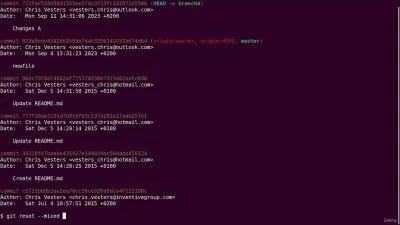Use JWT & Springboot-3 for API Authentication Authorization
Obify Consulting
1:34:56
Description
Develop production ready secure REST API's using latest JWT and Springboot 3 in 2024
What You'll Learn?
- You will about Authentication & Authorization
- You will learn about JWT - Json Web Token and its working
- You will learn to implement Springboot 3.3.5 with JWT
- You will learn to secure your REST API using Springboot 3 & JWT
- You will learn to develop applications with multiple roles
- You will also get the source code for the course.
- You will learn about global custom error handling
Who is this for?
What You Need to Know?
More details
DescriptionIn this course you will learn to secure REST API with Springboot-3 and JWT.
JSON Web Tokens (JWT) and Spring Boot together provide a powerful solution for securing web applications. JWT is a compact, URL-safe means of representing claims to be transferred between two parties. The token is digitally signed, allowing the receiving party to verify its authenticity. This is particularly useful in stateless authentication, where the server does not need to store session information.
In a Spring Boot application, JWT can be integrated easily for authentication and authorization purposes. When a user logs in, the server generates a JWT containing user information and permissions. This token is sent back to the client, which stores it (typically in local storage or cookies). For subsequent requests, the client includes the JWT in the HTTP headers, allowing the server to validate the token and grant access to protected resources.
To implement JWT in Spring Boot, developers can use libraries like jjwt for token creation and parsing. Spring Security can be configured to intercept requests and validate the JWT. By using filters, developers can ensure that each request is authenticated based on the token. This combination not only enhances security but also simplifies scaling, as each request is stateless, reducing server-side overhead and improving performance.
You will also get the source code for the course.
Who this course is for:
- Anyone who wants to implement JWT based Authentication and Authorization with Springboot 3.3.5 and Spring security
In this course you will learn to secure REST API with Springboot-3 and JWT.
JSON Web Tokens (JWT) and Spring Boot together provide a powerful solution for securing web applications. JWT is a compact, URL-safe means of representing claims to be transferred between two parties. The token is digitally signed, allowing the receiving party to verify its authenticity. This is particularly useful in stateless authentication, where the server does not need to store session information.
In a Spring Boot application, JWT can be integrated easily for authentication and authorization purposes. When a user logs in, the server generates a JWT containing user information and permissions. This token is sent back to the client, which stores it (typically in local storage or cookies). For subsequent requests, the client includes the JWT in the HTTP headers, allowing the server to validate the token and grant access to protected resources.
To implement JWT in Spring Boot, developers can use libraries like jjwt for token creation and parsing. Spring Security can be configured to intercept requests and validate the JWT. By using filters, developers can ensure that each request is authenticated based on the token. This combination not only enhances security but also simplifies scaling, as each request is stateless, reducing server-side overhead and improving performance.
You will also get the source code for the course.
Who this course is for:
- Anyone who wants to implement JWT based Authentication and Authorization with Springboot 3.3.5 and Spring security
User Reviews
Rating
Obify Consulting
Instructor's Courses
Udemy
View courses Udemy- language english
- Training sessions 28
- duration 1:34:56
- Release Date 2025/03/06










